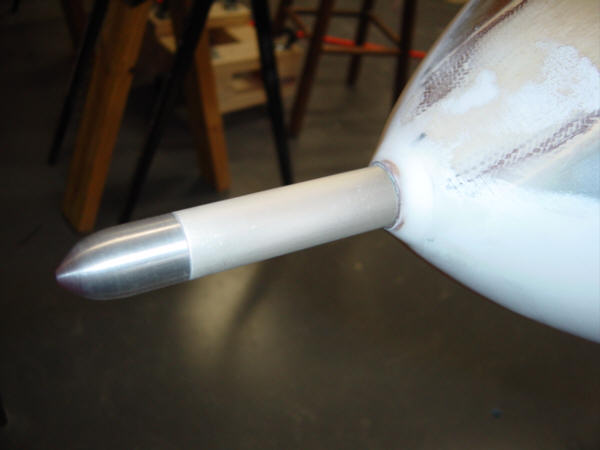

The pitot tube is a very important part of the aircraft - not only does it drive most of the flight instruments, it is the first thing on the aircraft...right on the nose cone. ;-) Actually, because it does provide some of the most important information to the flight instruments, it did warrant some special attention. It also provides the pressure sense for the gear safety switch, that keeps the main gear from being activated while the plane is on the ground. I choose to install a heated pitot tube. That's a good thing to have if in the clouds and encountering even just a little ice. Because it is up on the nose cone, ice can easily form and block the hole...effectively rendering all the pitot-static instruments useless - not good. So, heated it is. Besides that, I like the look of a thicker mast sticking out from the nose - more "fighter-esque". Another major point is this type of pitot tube is much more visable and rugged. So, maybe when the plane is parked with the nose down, airshow folk won't be stepping on it as much...and if they do, it can take much more punishment than just a little 1/4" aluminum tube. Note: after installation, it is so solidly mounted that I can lift the entire nose with the pitot tube - like a handle. Also a note to those curious button pushers out there (you know who you are): now that I have proven that it can be done, I don't want it done again! So, hands off my pitot! ;-p
Assembly was straight forward. The parts used are basically some 3/4"OD x .065 wall 6061-T6 aluminum tube, with machined end caps cut from 2024-T3 1" bar stock, a 1/4" 2024-T3 inner tube threaded on each end, and a 12v Cessna pitot heating element. I got that element off a Cessna parts supplier's web site - Broadie's Aircraft - $46 Cessna part# 0721105-5 (the invoice had a"/P" on the end too) Anyway, the heating element slides into the large tube with the small tube running through it while screwed into the bullet shaped mast head. The wires from the heating unit protrude from a small hole on the aft end of the tube and the end cap screws onto the other end of the inner tube - holding it all together. Because of the high temperatures generated by the heating element, I could not just drill a hole and flox it to the nose. I had to shape a phenolic collar to help dissipate the heat. Installation was simple - I floxed the tube into the collar, and the collar into the nose of the fuselage. I used a simple jig to hold the tube in the correct position for optimum readings at flight attitudes. With just the collar in place, it already looks pretty darn good.
Once cured, I went back with some micro and faired in the very tip of the nose. I'm very happy with how this turned out. I hope it clears the ground when I put the plane in a grazing position. ;-) (I'm kidding...it does)

Of course, the pitot and static systems work together to feed differential air pressure to the instruments. For the instruments to measure the differential, a static pressure source becomes the baseline for that calculation. Most aircraft have only one static port, but I chose to install one port on each side - this way, unusual attitudes (like slips) will not skew the readings. It also provides a redundant port in case something blocks or plugs one of the ports. The static port lines are run the same way as the pitot lines and terminate at the instruments.

In preperation for the DAR inspection, I had Bryan Wriston of Wriston Aviation come out to do the tests. I have to say, he is a top notch guy and has the latest top-notch test equipment - I wish I could say the same for MY equipment. In short, my plumbing and the little steam guages passed easily...the Microair T2000 transponder DID NOT! Also on the good side - a BIG thank you to Greg Richter and crew and Blue Mountain Avionics - the EFIS-Lite passed with flying colors!!! Either way, it looks like I'll have some course words for Microair in the next few days. Of course, I'll want to wait and have the whole pitot/static/transponder system signed off all at one time...so, I'll have to wait for it's return.
More updates in the Pre-Flight Prep section.
 Back to the Proto-page
Back to the Proto-page